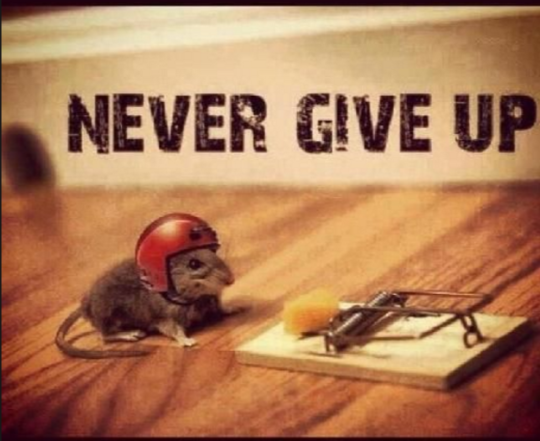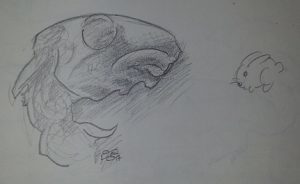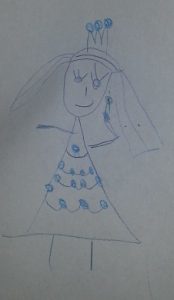Daniel M. Bensen's Blog, page 63
May 4, 2017
The Howling Specter of the Law
April 27, 2017
Awful Symmetry 3: Ecology and Animal Behavior
Living things capture and store energy in order to make copies of themselves. Theoretically, they could get energy from all sorts of places: the wind, tides, radioactive decay, chemical breakdown, light from a star. It’s that last that accounts for the vast majority of energy on Earth, and I suspect the same will be true for alien planets, too. (See Biochemistry for more on how life collects and stores sunlight chemical and radioactive energy).
We call the organisms that collect energy from nonliving sources autotropes (“self feeding” organisms) and the most familiar examples are plants. That’s the base of your food ecosystem. Plants gather sunlight (or whatever) and concentrate it in their bodies, making a tempting target for other organisms (heterotropes or “other feeding” organisms ). At this point, you’re probably thinking of an herbivore like a cow, but parasites like Rafflesia or aphids are just as guilty of stealing energy.
Other parasites work differently. Viruses, crown gall bacteria, and gall wasps trick a plant into using its energy to build structures useful to the parasite (more viruses, crown galls, and wasp galls respectively). But the terminology only matters insofar as you can google it to learn more.
What’s important is you have energy accumulators like plants and energy thieves like animals. The plants will probably be immobile, since moving around costs energy and you don’t need to do it to collect sunlight. Some animals might also be immobile (barnacles for example), but others will have to be able to move around if they want to gain access to new stores of energy.
You can get creative here. In what circumstances would a producer need to move (alien trees wrestling for access to light from a stationary sun on a tidally locked world?) and consumers might be able to stay still. Barnacles allow seawater to carry plankton to them, spiders wait for bugs to blunder into their webs, crocodiles ambush prey that wanders too close, cats stalk and pounce on mice. That’s a nice gradient from a food-rich environment where you don’t need to invest much in hunting, to a food-poor environment where you have to work harder.
In general, the further you move up the trophic levels (away from plants to herbivores to carnivores to hypercarnivores), the faster on its feet the organism has to be. More richness – more energy – means more trophic levels. Tropical jungles and coral reefs have more species than polar tundras and ice floes.
Energy isn’t all that matters, though. The mechanisms life forms use to gather and store energy have to be made of something. Without basic materials like water and nitrogen, you get a barren desert or a tropical lagoon (that water is crystal clear because it doesn’t have any plankton living in it). Polar islands manage some lichen, bugs to eat it, and maybe birds to eat the bugs before some local resource runs out and the food chain stops.
Evolution also plays a role as species become better at extracting what they need from the environment. Beans and their relatives, for example, use symbiotic Rhizobium bacteria to convert atmospheric nitrogen into nitrates, enormously increasing their range of habitats. Evolution takes time, though, so you can only expect organisms to “crack” a hostile environment if that environment is stable over evolutionary time scales. Expect lots of species diversity in old, stable, resource-dense, high energy environments.
Stability is important everywhere. The big hyper-predators are always the first to go when the environment gets unpredictable. Look at the extinction of every kind of dinosaur bigger than a quail. Look at which animals went extinct after the evolution of humans. A planet that just went through a global catastrophe or is home to a geo-engineering sapient species is not likely to have anything like tigers.
Although the real reasons species diversity decreases with latitude are more complex. See Currie et al. (2004). “Predictions and tests of climate-based hypotheses of broad-scale variation in taxonomic richness”. Ecology Letters. 7 (11): 1121–1134. doi:10.1111/j.1461-0248.2004.00671.x.
Behrenfeld1 et al. (2006) “Controls on tropical Pacific Ocean productivity revealed through nutrient stress diagnostics” Nature 442, 1025-1028 ) doi:10.1038/nature05083

April 20, 2017
Awful Symmetry 2: Hungry Not Evil
I read a book once in which a team of intrepid space archaeologists find themselves menaced by an army of crablike aliens. Each crab is about the size of a basketball, but in a swarm of hundreds, their taste for human flesh cannot be denied!
And there’s the problem. Why would alien predators instinctively attack such exotic prey as humans? And if they did, why would they collect into a swarm in order to obtain a couple hundred kilograms of flesh?
Compare that behavior to real swarms. South American army ants and African driver ants do collect into large mobile colonies and march from one place to another, devouring whatever animals they find along the way. But the mass of the food they collect must be at least a 40% of the mass of the swarm and the ants don’t bother to pursue prey or tackle animals that put up too much of a fight. Ant or tiger, for a predator, every attack is a gamble and devoting all your energy to an extended chase after unknown prey is just not worth the effort.
Authors want to make animals malevolent, but just like with human characters, antagonists are more interesting when their motivations extend beyond pure evil. Real animals attack people because they are hungry, frightened, angry, or in some cases, just curious.Those behaviors evolved for a reason, and that reason is the way the animal in question fits into its ecosystem.
So what is your monster hungry for and why?
Assuming a mass per ant of .001-.005g, a colony population of 100,000-600,000 and given the daily food intake of 38.2g given for Eciton hamatum by Powell, S. Insect. Soc. (2011) 58: 317. doi:10.1007/s00040-011-0152-3

April 16, 2017
My schedule at Miscon!
It’s still tentative, but it looks like I’ll be at a whole bunch of Panels at Miscon (Missoula, Montana May 26th to 29th)
(Tentative)
 Fri 5:00 – 5:50 PM, How to Appear Human, RocketTent (1)
Fri 5:00 – 5:50 PM, How to Appear Human, RocketTent (1)Panelists: Daniel Bensen, Ty Hulse, Tex ThompsonWe all want to make friends on Earth, but we don’t always know how. Human social customs are strange and complex, and can baffle even the most well-meaning being. Make the most of your time at this convention by learning some ways to have fun while talking to humans.
Panelists: Daniel Bensen, Tex Thompson, Ty Hulse
 Sat 11:00 – 11:50 AM, How People Actually Learn Languages, Glacier
Sat 11:00 – 11:50 AM, How People Actually Learn Languages, GlacierPanelists: Daniel BensenIt Doesn’t Happen in a Montage. Language-learning is much harder, and much more interesting, than most books and movies make it look. It has a lot to do with the inner workings of both our minds and our cultures.
 Sat 2:00 – 2:50 PM, Build a Better Monster, Ballroom C
Sat 2:00 – 2:50 PM, Build a Better Monster, Ballroom CPanelists: Daniel BensenBuild a Better Monster: Biology and Creature Design in Scifi and Fantasy
Not all monsters are created evil. The best ones don’t look like they were created at all, but evolved like real animals. We’ll talk about the ecology, bio-mechanics, and phylogeny of creature-creation — that’s everything you need but the test tube full of mutagen.
 Sat 3:00 – 3:50 PM, “And” As a Verb, Gallatin
Sat 3:00 – 3:50 PM, “And” As a Verb, GallatinPanelists: Daniel Bensen, Fiona Jallings (dreamingfifi), Frog Jones, Alyson PetersonWhat kind of language will an alien speak? Probably nothing you can speak without an abacus, a swimming pool, and a chamber choir. As different as human languages can be from each other, there are certain things they all do. What if they didn’t?
 Sun Noon – 12:50 PM, The Grammar Panel, Glacier
Sun Noon – 12:50 PM, The Grammar Panel, GlacierPanelists: Daniel Bensen, Claire Eddy, Andrea HoweReturning once again this year: the Grammar Panel! Bring all your grammar-related questions and let the learning begin!
 Sun 5:00 – 5:50 PM, Kingdoms Outside Europe, Gallatin
Sun 5:00 – 5:50 PM, Kingdoms Outside Europe, GallatinPanelists: Daniel BensenYour fantasy kingdom doesn’t have to be based on Plantagenet England. Why not the Ottoman Empire, the Aztec Triple Alliance, Heian Japan? There are a lot of ways to be a king.
Panelist: Daniel Bensen

April 13, 2017
Redundant English
I’m not feeling in a scifi mood today, so let’s play with languages!
I was thinking about redundancy. There’s a certain amount of information in a given clause in English. What if we made sure that every word in the clause carried that information? Wouldn’t that be nice? Shut up, yes it would.
Consider the first sentence of Ted Chiang’s sublime short story “Exhalation:”
It has long been said that air (which others call argon) is the source of life.
The core of the sentence is “argon is the source.” Which fits the formula “It is the it.” Redundifying the sentence gives us: “Argon-is-the-it it-is-the-it it-is-the-source.” Or, clumping everything together and making it easier to say: Argonsthit itsthit tsthesource.
Doing that to the rest of the sentence gives us a weird, agglutinative mess.
Tsbeensaid long that — Airsit — chothersdoit chithecallit chitheydargon— itsthesourceofit thitoflife — stbeendone.
Or you can just say thitoflife stbeendone, meaning “Something has been done to something related to a thing of life.” Expressive!
And now I’m tried. Go read that short story.

April 12, 2017
My Friend Sent me a new Razor
This was my response

This was his response


April 10, 2017
Ways to fly
That was some good brainstorming @archipithecus and @exxos-von-steamboldt, but I think we have a ways to go with these flying stem-mammals.

April 6, 2017
Switching Dinosaurs and Mammals
The Triassic was a battleground, in which dinosaurs and mammals warred to see who would inherit the niches left empty after the Permian extinction. At first, both sides seemed equally matched, with dinosaurs like Eoraptor (1) competing more less directly with mammals like Cynognathus (2). The two groups rapidly diverged, however.
Mammals grew every larger and more diverse over the course of the Mesozoic, evolving into towering tree-browsers (10), low-grazing giants armed with plates (11), spikes (12), and tusks (13) as well as predators large and ferocious enough to conquer these defenses (6).
Small, nimble dinosaurs were better suited for life in the shadows. They dug under the ground (3) and climbed trees (4) to escape from mammals, only venturing onto the ground at night, aided by dark-adapted vision, smell, and hearing keener than any mammal’s (5, 6). Some even became modest hunters themselves (7).
Where dinosaurs excelled was reproduction. Mammals took care of their young after hatching, but one group of dinosaurs carried their eggs and chicks with them in a mobile nest or pouch evolved from the forelimbs (8,14). It was this lineage that would go on to rule the Earth after the next extinction.

April 5, 2017
Draw the Rabbit Skull, Daddy
“Draw the rabbit skull, daddy,” she said. “We’ll be conservationists together,” she said.
So I drew the rabbit skull.
And so did she.
“I can’t draw rabbit skulls, daddy. This is a dolly pretending to be a princess. She has blue diamonds on her dress.”










